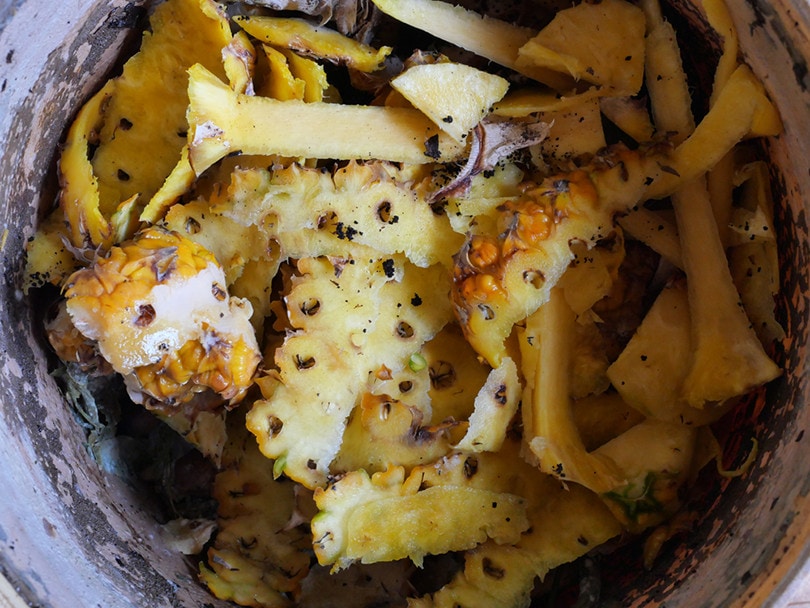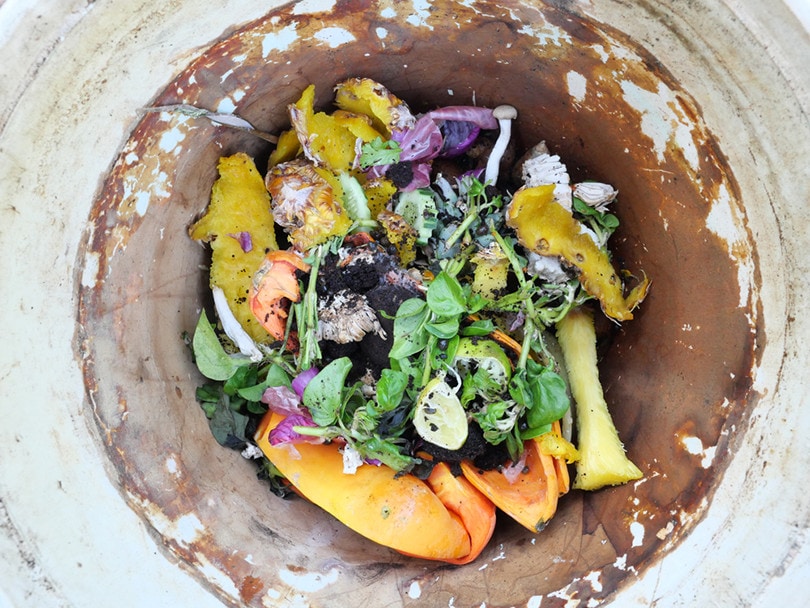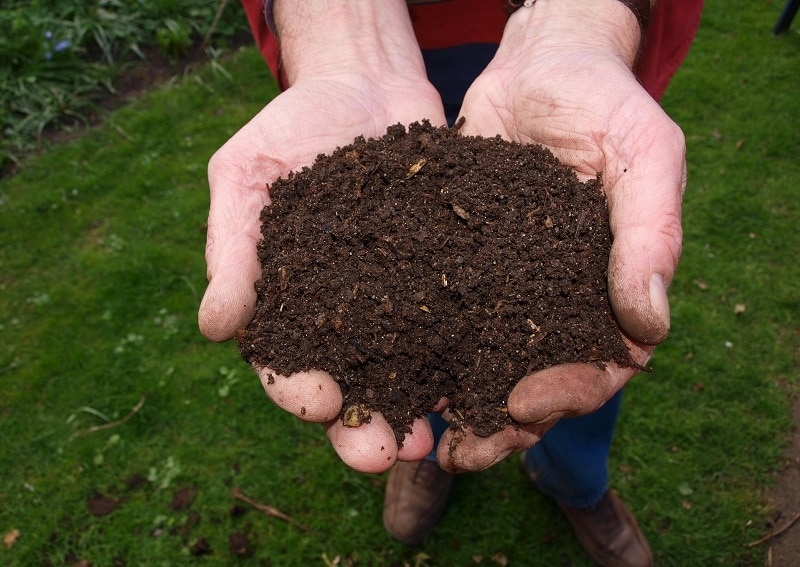Can You Compost Pineapple? What You Need to Know!
-
Kristin Hitchcock
- Last updated:

You can compost all the parts of pineapple, including those that you would not necessarily eat. It has high moisture content and a good structure, which allows it to break down very quickly and easily. Of course, the skin and dryer parts of the pineapple will take a bit longer to break down, as they are much dryer.
With all that said, most people do not have a problem composting pineapple. You don’t have to do anything special as long as you’re following the usual guidelines for composting.
Furthermore, pineapples contain citric acid, which works as a preservative. In fact, many processed foods include citric acid as a natural preservative because it stops the composition process. If you decide to add pineapple, therefore, you’ll likely need some sort of deacidifying process if you want the pineapple to break down quickly.
You also want to cut the pineapple up into smaller pieces, which will aid in the decomposition. The more surface area you expose, the faster the fruit will break down.
Depending on where you purchase the pineapple from, you may also need to wash it to prevent pesticides from ending up in your pile. Plus, you don’t want these pesticides in your yard or garden, either.
Can You Compost Pineapple Skin?
You can compost the whole pineapple, including the skin and crowns. These materials are a bit dryer than the fruit part of the pineapple, but they are still more than compostable if given enough time.
You should cut them up into small pieces when composting them, as a bigger piece will take a long time to compost down properly. If you don’t cut them up, the pieces will decompose eventually, but the smaller surface area will mean that it will take much longer.
The skin is also known for being contaminated with pesticides. Therefore, we recommend washing them well before adding them to the pile. You don’t want these pesticides in the pile, as they can harm the compost and your garden.
Pineapple peels contain a lot of nitrogen, so be sure you’re balancing out the pile with lots of carbon. Just nitrogen is not very good for practically any plant.

Can Pineapple Acid Ruin Your Compost Pile?
Many people are concerned about the acid content in a pineapple. While pineapples are extremely acidic, they do lose a lot of that acid when they ripen and age. Obviously, when the pineapple is sitting in the compost bin, it is aging and ripening. Therefore, they won’t leave that much acid inside the compost bin.
You can add items to your compost pile to adjust the pH if you add a lot of pineapples. However, you can often add small amounts of pineapple without a great effect on the pH. When in doubt, test before you adjust.
In some cases, you may need to add hydrated white lime to balance out the pineapple. It dilutes the acid, which can prevent potential harm from occurring to the pile. It reacts to the acids in the compost pile and eliminates them—something that is often necessary to improve the decomposition process. As the acidity decreases, the pineapple should decompose faster.
To use the lime, simply sprinkle some on top of your compost pile when you add the pineapple. You can also add it shortly after you’ve put the pineapple in. However, the faster you use it, the better. The amount you need to use varies but it is typically around ½ cup per pineapple.

How to Compost a Pineapple
There are a few steps you should take when composting a pineapple. These steps will ensure that the pineapple breaks down efficiently and doesn’t leave too much acid in your soil.
- Rinse and break down the pineapple. You should rinse the pineapple well (especially the skin and outer parts) and cut it as small as possible. The smaller you cut it, the faster it will compost. Rinsing is vital to remove pesticides and other residues that may harm your compost pile.
- Mix the pieces into the pile. Next, mix all the pieces into the pile. Spread them throughout the compost pile. The middle of the pile usually composts the fastest, so you may want to add the toughest parts to the center to promote efficient composting. Furthermore, it is often best to add in needles, dry leaves, and other brown materials to keep the right balance in your compost bin. Be sure to mix them well, as pieces sitting on the top can attract pests and bugs.
- Keep the pile wet. You want the compost pile to stay moist to encourage composting. Otherwise, the pile can stagnant and draw pests.
- Balance the acidity of the pile as necessary. If you used a lot of pineapples, you may need to balance out the acid. Adding brown material can help this, as well, since most of it is not acidic. Try using three parts “brown” material to one part “green” material.

Benefits of Composting Pineapple
While pineapple may be a bit harder to compost, there are several benefits to adding it to your pile.
1. High Moisture Content
Pineapples are very moist, as you probably know if you’ve ever eaten one. While this does make them break down slower, it helps the pile hold onto moisture, which is important for composting. Having only dry materials can lead to a compost pile that dries out very quickly.
2. Improved Soil Texture
Pineapple contains quite a bit of calcium, which can improve the texture of the soil. High amounts of calcium encourage water penetration and prevent soil from becoming too compacted. Therefore, high-calcium soil is often quite helpful in a garden.
3. Ecological Benefits
Pineapple is high in sugar, which attracts earthworms. If you’re using earthworms in your composting process, then this is very beneficial. Pineapple is also mostly inedible. You can only use the inner parts of the fruit. Therefore, there is usually a lot of pineapple left over to compost.
4. Added Nutrients
Pineapple tends to add quite a few nutrients to the soil. It can be a great source of calcium, zinc, and phosphorous—all of which are important for your plants. They can also add antioxidants to the soil, which can help then plants grow further.
- Related Read: Can You Compost Cheese? What You Need to Know!
Conclusion
Pineapple can be a bit trickier to compost than other items, mostly because it takes longer. However, it can be composted rather easily, especially if you aren’t adding a bunch of pineapples. While it is acidic, there usually isn’t enough acid in it to matter. The acid will dissipate as the fruit ripens and begins to break down.
However, because it contains citric acid, it can be challenging to compost compared to other green materials. Therefore, plan on giving the pile more time to break down the pineapple than you might other materials. Also, be sure to add plenty of browns to help encourage further composting. Otherwise, your pile can become unbalanced.
If you’re only using leftover pineapple, though, you can usually just add small pieces directly to the pile without a problem.
Featured Image Credit: Anant Kasetsinsombut, Shutterstock
Contents
